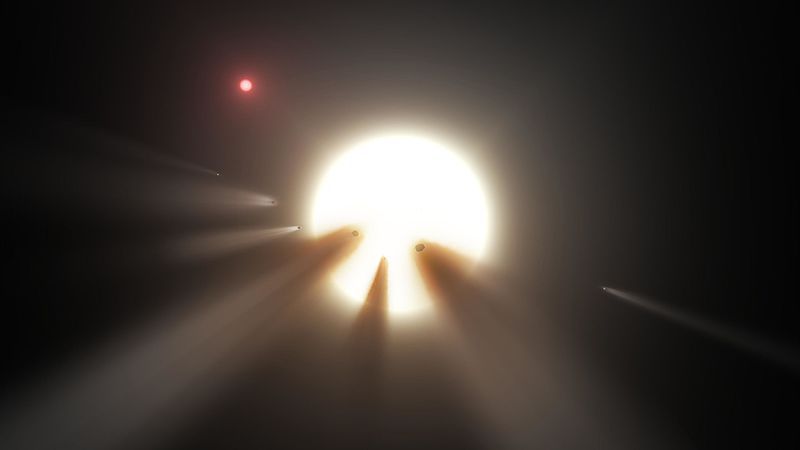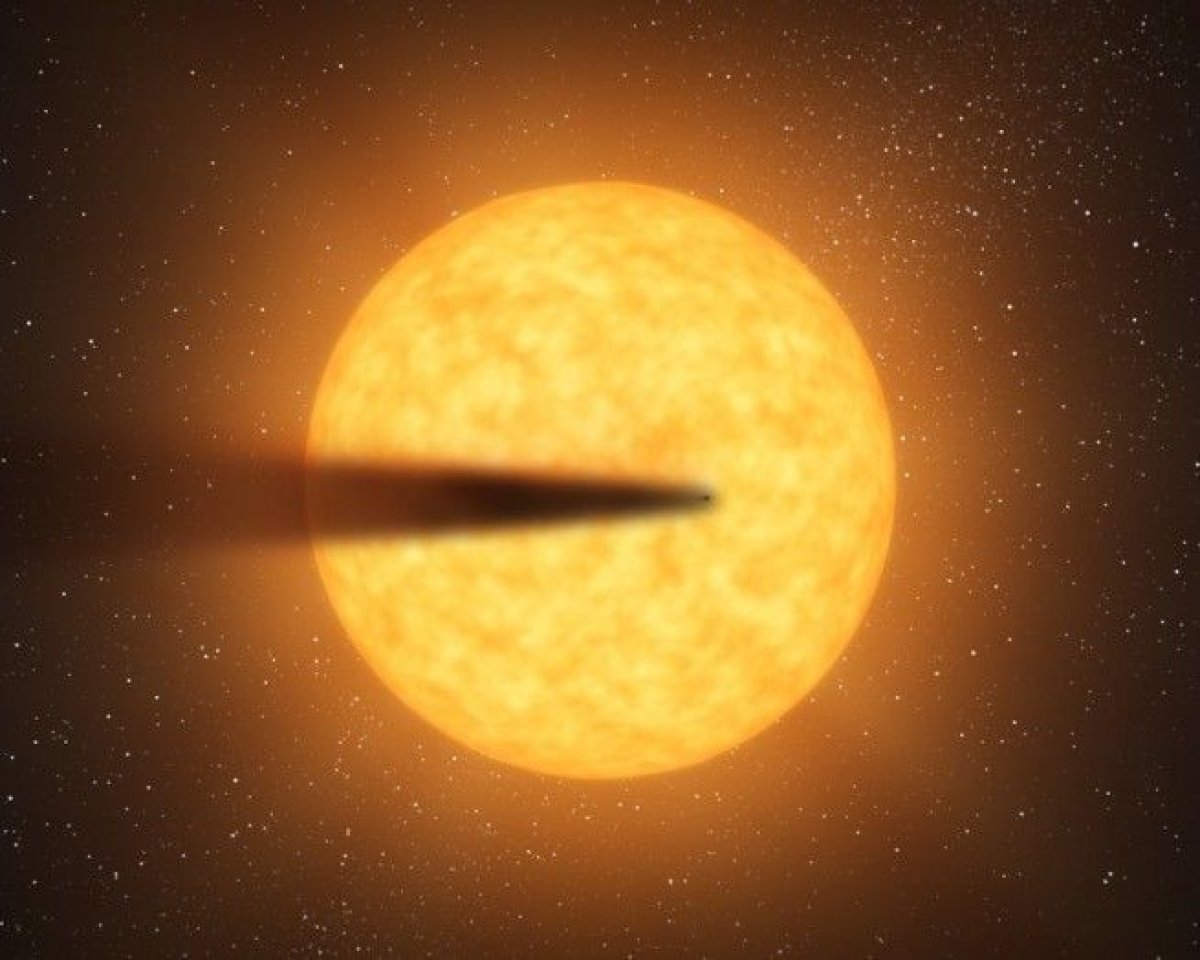
A strange star that has baffled astronomers for more than two years has started displaying highly unusual behavior again, leaving astronomers excited at the prospect of finally finding out what exactly is going on.
KIC 8462852 is star with a mass about 1.5 times the size of the sun, and it's almost five times brighter. In 2015, astronomers led by Tabetha Boyajian of Louisiana State University announced something very odd was happening to the star's luminosity, or brightness.
Astronomers normally track a star's luminosity in order to find out about the planets orbiting it. When a planet passes in front of a star, some of the light is blocked out, and the luminosity drops.
After analyzing data from the Kepler Space Telescope, scientists discovered huge dips in KIC 8462852's brightness that lasted between five and 80 days, with the star sometimes losing as much as 20 percent of its luminosity.
A dip of 20 percent means something absolutely ginormous must be passing in front of it. To put it into perspective, if we were observing Jupiter (the biggest planet in our solar system) passing in front of the sun from a distant galaxy, it would block out around 2 percent of the light. The dimming was also irregular—a planet passing a star would take place at regular intervals, with the same dip in brightness each time—and it varied in intensity. Often there were just small dips of a few percent.
That meant whatever was causing those dips was a mystery.
Ever since KIC 8462852's weird behaviour was discovered, scientists have proposed several hypotheses: a huge family of comets swarming the star; another massive and as-of-yet undiscovered star; KIC 8462852 consuming a planet. But none have been able to fully explain the dimming.
A more headline-grabbing proposal was that the dips were the result of an "alien megastructure." Theoretical physicist Freeman Dyson had popularized the idea of such a structure back in the 1960s. He said that an advanced alien civilization would eventually develop the technology to harness energy from its star. One way to do this would be to build a huge structure around said star, that could generate power from it.
While scientists generally agree that this is a very remote possibility, it cannot be completely ruled out. Researchers with the Search for Extraterrestrial Intelligence (SETI) looked for radio signals coming from the star's galaxy (which could be a sign of alien life) but failed to find any.
Over the last two years, astronomers have continued to monitor the star for further signs of activity. Being able to watch the dips as they are happening with a variety of telescopes and instruments will allow them to take more accurate measurements—potentially allowing them to find out what is going on.
@LCO_Global 0.4m data in r'-band shows the new #TabbysStar dip is complex, and it is still dipping! pic.twitter.com/Eu8TYLOUlo
— Dr Tabetha Boyajian (@tsboyajian) May 21, 2017
On May 19, Boyajian announced that KIC 8462852 had started dipping again, causing a flurry of excitement. Jason Wright, associate professor of astronomy and astrophysics at Pennsylvania State University, who initially proposed the possibility of an alien megastructure, tweeted: " @tsboyajian's star is dipping. This is not a drill. Astro tweeps on telescopes in the next 48 hours: spectra please!"
In a YouTube discussion about the dimming on May 19, Wright said they had been "on alert" for around a week before the dimming fully began. "Just in the last two days it got suddenly dimmer," he said, adding that they had confirmed the light from the star had dipped by 3 percent. "That was enough to say this was no statistical fluke."
Following the announcement, astronomers around the globe took time from their own scientific research and turned their telescopes to KIC 8462852. The data from their recordings is now being filtered back to the teams involved.
Wright said they do not expect to solve the mystery of KIC 8462852 anytime soon; they are currently analyzing a huge amount of data collected. "We have data we haven't even had a chance to look at yet," Wright tells Newsweek. "We are literally just trying to figure out how to put it all in one place so everyone can see it organized in a way that people know how to use it.
"We want to let anyone who wants to work on this help. This is the first clear dip we've seen since the Kepler mission [where the dips were initially noticed]."
Wright says the periods of dimming are "unpredictable," though previous data indicates they occur in bunches. "So we're hopeful this is just the first of many, and hopefully even deeper, dips to come in the near future. But even if not, even if it's another year, we have so much data I'm sure we'll be able to exclude some possibilities."

At the moment, it looks like the current dip is coming to an end. "Of course we don't know, and we don't know if another is about to start," Wright adds.
Since the latest dip began, two new proposals for the cause have been put forward. Both appear on arxiv.org, an online server where scientists can share their research before it is formally published. The first proposal suggests an object in the outer solar system, while the other points to a massive planet with two trails of "Trojan asteroids."
The second, Wright says, is a "very creative proposal." The study suggests there is a large planet orbiting KIC 8462852. This planet is preceded and followed by a huge cloud of Trojan asteroids. The orbital period is 12 years, so we should see a full cycle of dimming again in 2021.
"It's a neat proposal," says Wright. "It addresses some but not all of the weirdnesses of the star. It's a very clever way to explain why there were quite a few dips at the beginning of the Kepler mission, then not very many except for one very extraordinary dip that occurred about halfway through. And then a very large number of dips at the end.
"I should say there are still some big difficulties with this model. At the moment it's just a proposal, it's not a fully fleshed-out model. It's very clever but it doesn't explain a long-term dimming we see, or the lack of infrared. It also proposes some phenomena that are at least as extraordinary as anything else that's been proposed."
However, if correct, scientists would be able to confirm it within the next decade. "It has to be a 12-year period. So it has to come back," Wright says. "I hope we will have figured it out by then—but if this is right, then we might see a repeat performance of the asteroids in 2021, and eventually the planet itself."
Uncommon Knowledge
Newsweek is committed to challenging conventional wisdom and finding connections in the search for common ground.
Newsweek is committed to challenging conventional wisdom and finding connections in the search for common ground.
About the writer
Hannah Osborne is Nesweek's Science Editor, based in London, UK. Hannah joined Newsweek in 2017 from IBTimes UK. She is ... Read more
To read how Newsweek uses AI as a newsroom tool, Click here.








